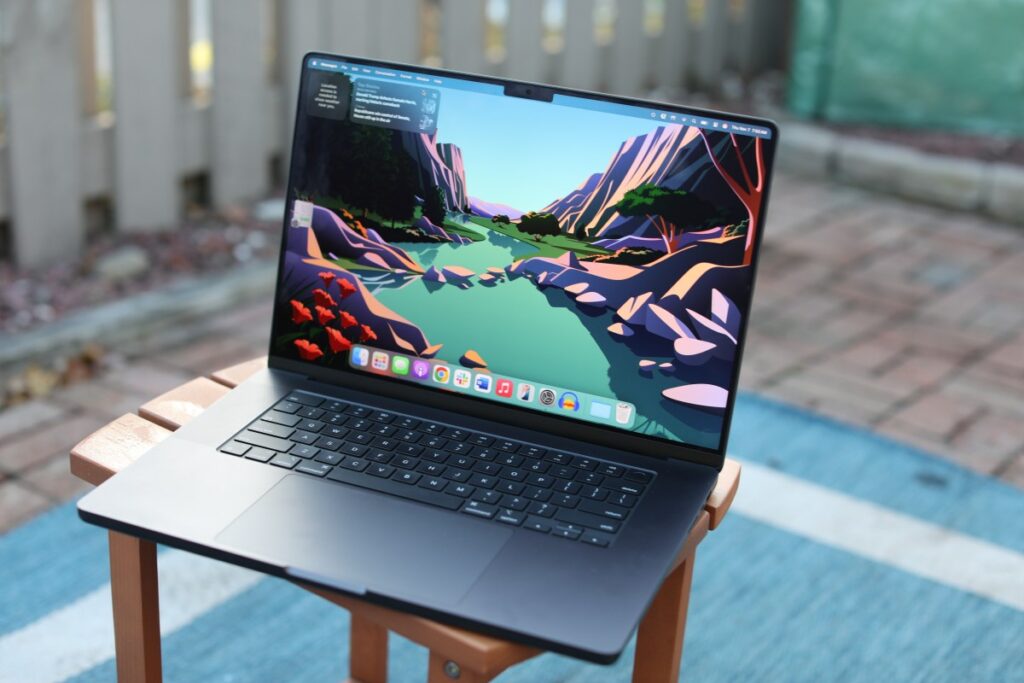On Monday, Bloomberg reported on Apple’s plans to fully overhaul its laptop line. That’s exactly the kind of rumor you don’t want to drop in the week between the announcement and launch of a new MacBook Pro. A deeper dive reveals that the planned revamp is coming at some point in 2026.
It’s still very much a rumor/early report, meaning that it might not happen in that timeframe — if, indeed, it happens at all. A lot can change in 1.5 years, especially in this world of consumer electronics. But not all that much has changed since Apple’s premium laptop was released this time last year.
In fact, MacBook Pro releases are now more or less like clockwork. It’s an annual ritual built around the arrival of a new chipset, not unlike the iPhone release schedule. There’s no guarantee that Apple will continue the current release cadence for the M-series of chips, but it seems to be working well for the company so far.
Apple has its work cut out for itself, if it plans to deliver an iPhone and MacBook that are “the thinnest and lightest in their categories across the whole tech industry,” as the report states. The M-series delivered a much-needed shot in the arm to the line, making the last few generations of MacBook not only the most powerful, but the all-around best the company has delivered.
Efficiencies delivered via Apple Silicon are at the heart of the new Mac Mini overall, allowing the company to significantly shrink down the desktop’s size. The question isn’t whether the M series will result in a literal thinning of the line; that much seems obvious. What is less clear, however, is whether sacrifices will be required.
For one thing, the Pro line’s processing power have thus far required Apple to include a fan — something now absent from the Air. For another, battery life is now a hallmark feature. I’m old enough to remember when liveblogging an event required me to haul an external battery around. These days, I don’t even have to think about plugging my MacBook Air in on a cross-country flight — which is great, because Delta’s seat-back power outlets are and have always been a disaster.
Apple rates the new Pros at 24 hours on a charge. If Apple wants to sacrifice a literal full day of battery life at the altar of making the laptop thinner, they’re going to have to pry it from my cold, dead hands.
The question of whether to buy now or wait for the next upgrade will forever loom over major consumer electronics purchases; that’s just the nature of the annual release cycle. That said, an early rumor about a major upgrade arriving at some point in 2026 shouldn’t move the needle much for those wondering whether to pull the trigger today. This time next year may be a different story.
MacBook Pro vs. Air

For the time being, the buying advice remains largely unchanged from the last several years. If you’ve budgeted for a MacBook Pro, now is a fine time to get one. The refreshed M4 chips bring nice performance gains over last year’s, as the line continues to evolve and improve.
The MacBook Air continues to be the best choice for the vast majority of users. It’s more affordable, lighter weight, and performance differences are largely negligible for most non-professional tasks. The Air’s base RAM was increased to 16GB, but the line remains otherwise untouched.
They still sport the M3 chip, and that’s extremely unlikely to change this year. If Apple Intelligence is central to your purchasing decisions, going forward, know that the new features will be compatible with any M-series Mac, which now covers four years of laptops.
There’s a reason so much of the press material around the Pro involves things like 3D animation, music production, and resource-intensive STEM pursuits. At a certain point, enhanced performance on the high end has little impact on most users. That’s not to say such updates aren’t welcome, of course. For those who work in video editing or the sciences, for example, such breakthroughs could dramatically reduce the time required to execute such tasks.
Apple’s site suggests that “There’s never been a better time to upgrade.” That is, perhaps, true in the sense that these devices are continually improving. It’s less so, however, when assessing how dramatic a shift the line has made from generation to generation. From that perspective, the shift from Intel to the M1 was far more significant.
It’s also true that upgrade cycles are generally longer for laptops than smartphones, with respective averages of five and three years. Obviously, Apple like every other hardware company, would love it if you upgraded more often, but you’re a good person who is both concerned about e-waste and not made of money.
M4 the win

By default, Apple compares the new M4’s performance to the last generation of Mac Intel processors, released in 2019, with a drop down that also features the M1 models. That’s fair enough, given the standard lifespan of a laptop — in fact, it may overly optimistic on Apple’s part.
The company says the new M4 line is up to 9.8x faster than the Intel models and up to 3.5x faster than the M1 Pro and M1 Max. For its own purposes, Apple used an M4 chip with 10-core CPU, 10-core GPU, and 32GB of RAM. The test involved using Adobe Premier 2024’s Scene Edit Detection feature on a 3.5-minute clip. Your results will almost certainly vary, based on your hardware configuration, system settings, and the given task.
The model Apple sent to TechCrunch for review purposes is a 16-inch M4 Pro with a 14-core CPU, 20-core GPU, 48GB of RAM, and 2TB of storage. The laptop runs $3,649 as configured. That’s $1,150 more than the base 16-inch M4 Pro model and a full $2,050 more than the base 14-inch M4 MacBook Pro. Even so, that puts review model in the middle of the pack, price-wise. If you really want to go all out, the 16-inch Pro with a nano-texture display, M4 Max with 16-core CPU and 40-core GPU, 128GB of memory, and 8TB will run you $7,379.
Some things to keep in mind when spec-ing out your system. First, the 14-inch MacBook Pro is available in M4, M4 Pro, and M4 Max. The 16-inch only comes in M4 Pro and M4 Max flavors. At present, these are the only MacBooks with M4 chips at present. The iPad Pro was the first model with the processor, and the MacBook Air did not — and likely will not — get the upgrade in 2024.
You can find the full run down of the differences between the M4 models here. The long and short of it is the number of CPU and GPU cores available (the AI-focused Neural Engine is 16 cores on all modes) and memory bandwidth speeds. Memory bandwidth is more or less what it sounds like: the speed with which data can be read or written on memory by the processor. The range here is 120GB/s up to 410GB/s.
Another key difference between the chips are their Thunderbolt support. The M4 supports Thunderbolt 4, with speeds up to 40GB/s. The M4 Pro and Max are the first Apple chips to support Thunderbolt 5 at up to three times the speed. For most, this will amount to futureproofing. The simple fact of it is that if you don’t know what Thunderbolt generation your cables and accessories support, it’s almost certainly not 5.
All three chips are more than capable for everything the vast majority of us throw at our systems, day-to-day. Aside from improved graphics processing for gaming, it’s hard to recommend the price increase that comes with the Pro and Max models for most users. In fact, it’s also hard to recommend the MacBook Pro instead of the Air for a majority of us. Even without the upgrade to M4, the Air remains the best MacBook for most.
The one upgrade option I’m surprised I’ve not seen more people mention is the addition of a nano-texture display for the first time ever on a MacBook. Apple notes,
The new MacBook Pro introduces an all-new nano-texture display option that dramatically reduces glare and distractions from reflections. In bright lighting conditions, the new MacBook Pro can now show SDR content at up to 1,000 nits and still displays HDR content at up to 1,600 nits of peak brightness. All together, it’s a game-changing experience for users working outdoors.
Simply put: If you’re buying a new Pro and plan to go outside ever, spend the additional $150. I presently have two Studio Displays on my desktop. One is nano-textured, the other isn’t. It makes a huge difference, even indoors. In fact, at one point I rearranged the two screens in a way that minimizes the glare from the one window in the room.
Glossy displays on Macs are one of those things we complained about years ago, but at a certain point, many of us were worn down by Apple’s refusal to offer an alternative over the years. I had given up on the idea years ago. Now that it’s available, I plan to get it for any MacBook I get, going forward. Working outside a couple of times a week is a great way to break up the monotony of an office job.
MacBook tank

It may be the fact that I’ve been carrying around a 15-inch Air since my review back in March, but the 16-inch Pro is a freaking tank. At 4.7 pounds, it’s 1.3 pounds heavier than the 14-inch Pro and 1.4 pounds heavier than the 15-inch Air. The overall footprint is naturally larger, owing to the difference in screen sizes, but the 16-inch is notably thicker, as well, at 0.66 inch, 0.05 inch thicker than the 14-inch Pro and 0.21 inch thicker than the 15-inch Air.
That last bit is thanks, in no small part, to the Air’s somewhat ironic lack of a fan for cooling. Because of this, the Air will throttle performance. Some people may find themselves triggering the fan while gaming. Otherwise, it won’t make much of a difference for most users.
Ultimately, the 16-inch Pro is spiritually in line with what were once commonly referred to as “desktop replacements.” If you frequently find yourself working outside the office, it’s a pain to lug around. If, however, you’re looking for something with near desktop specs and a bit of flexibility, the Pro is closer to that sweet spot.
Ports continue to be a differentiator between the tiers. The Pro has three Thunderbolt/USB-C ports, an HDMI port, and an SD slot, whereas the Air only sports a pair of USB-Cs. More ports is generally better, and it’s great to see Apple continuing to include an SD reader on the laptop.
Both the M4 and M4 Pro chips support two external displays with up to a 6K at 60Hz, or either one 8K at 60Hz or one 4K at 240Hz. Upgrading to an M4 Max brings support for up to three 6K displays at 60Hz or one 6K at 60Hz plus one 4K at 240Hz.
Upgrade time?

The annual MacBook upgrade cycle means there largely isn’t much daylight between this year’s model and last’s. There’s little reason to have FOMO if you have any of the M-series models. The models released over the last four years have been among the best laptops Apple has ever released, owing to a combination of first-party silicon, product design and just general responding to consumer requests and complaints.
It’s unclear what a 2026 line refresh might hold, but as it stands, the M3 Air is still the best MacBook for most. If money and back pain are no object, however, the M4 series or Pros are a beast.


